Follow along with the video below to see how to install our site as a web app on your home screen.
Note: This feature may not be available in some browsers.
Yes, you're right....... because the electronic parts are cheap junk bought on ebay with no manufacturer's name and no datasheet.
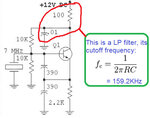
Excellent answers, I benefited a lot of them, Thank you Brian.Q1. Buy parts from a reputable supplier. If that isn't possible, the best you can do is make a guess, most Quartz crystals are designed around 15 - 30 pF load capacitance.
Q3. Correct.
Brian.
OKQ2. Almost certainly it isn't critical, the values only determine the impedance at the collector.
Xc of that 10n capacitor @ 7MHz = 2.27Ω ,, yes short circuitThe capacitor is essentially keeping the collector at ground signal level
How???? it is very small value?and the resistor is providing a degree of signal isolation from supply line noise.
Q5: the base voltage (VB) = 6 volt, VE=5.4 volt (if VBE=0.6 V),,, IC = VE/RE= 2.45 mA
I think that IC is relatively large and the circuit designer could accomplish the same performance if he work with 1mmA or even 0.5mA. Do you agree with me in this opinion?
Q4: (Repeated): For the RC Low Pass Filter shown below, is it important to have a frequency of 159KHz, or it is not critical?
broken link removed
Q5: the base voltage (VB) = 6 volt, VE=5.4 volt (if VBE=0.6 V),,, IC = VE/RE= 2.45 mA
I think that IC is relatively large and the circuit designer could accomplish the same performance if he work with 1mmA or even 0.5mA. Do you agree with me in this opinion?
I mean from the very beginning that the frequency of 159 KHz is far away from the operating frequency (7MHz) and also far away from the electricity humm (50/100 Hz).The RC combination is an optional power supply filter, intended to remove switching noise or RF signals generated by other parts of the circuit. Dimensioning isn't critical at all, in case of doubt, you'll use a larger capcitor to imoprove the filter effect.
Sure. But it depends on the input capacitance of the stage which receives the oscillation power from the emitter output. With too large input cap, oscillation might not start. Should be worst case, corner and - if possible - MC simulated.
I'd expect better answers than those you have given me like tell me that the filter must have frequency ranges between X & Y.Re the 100 ohm resistor:
Playing with simulations I have seen values work from 100 to 1000. It provides some degree of isolation between the oscillating loop and the power supply, so the oscillating loop can exhibit wider voltage swings.
Those are in the range of reasonable levels. It is usually possible to adjust a value or two somewhere, and get the circuit to oscillate. You might adjust the bias current, or supply voltage, or emitter resistor, collector resistor, etc.
Some of it depends on the characteristics of the real transistor you use.
Is the 100Ω resistance and 10 nF cap are a low pass filter or not?
Not exactly calculate, but at least I can estimate the input capacitance of the next stage. Or even better: analyze it by simulation!Sorry do not tell me about things that can not be calculated! can you calculate the input capacitance of the stage?
The current determines the emitter output resistor, by this the output capacitance of the oscillator stage to the next stage. Lower current needs higher resistance, so generates higher output impedance. This - on the other hand - determines, if the output impedance is low enough to drive the input impedance of the next stage. If this isn't true, the oscillator won't start oscillating. Try it by simulation!Then what is the relationship between current and input capacitance?
Yes, as we repeatedly stated, it is to let clean DC reach the oscillator from the supply line so it doesn't risk being modulated by supply line noise. The capacitor also keeps the collector at (very close to) ground from the oscillation perspective.
Do not read too much into the 159KHz figure, it is not relevant to the oscillators function, the values were chosen as 'mid-range' suitable ones rather than being calculated for a specific cut-off frequency. Personally, I would probably add an additional capacitor of 1uF to 10uF across the 100nF for even better supply rejection.
Brian.
Not exactly calculate, but at least I can estimate the input capacitance of the next stage. Or even better: analyze it by simulation!
yesThe current determines the emitter output resistor,
I could not understand this sentenceby this the output capacitance of the oscillator stage to the next stage.
That's OKLower current needs higher resistance, so generates higher output impedance. This - on the other hand - determines, if the output impedance is low enough to drive the input impedance of the next stage. If this isn't true, the oscillator won't start oscillating. Try it by simulation!
If you have the right models, simulation results are much closer to reality than simple estimations.You and I know that simulation programs are often far from reality.
You can do that, but I think it's not necessary.Would you recommend fitter program that is close to some extent to the real world.
could not understand this sentenceby this the output capacitance of the oscillator stage to the next stage.
by this the output impedance of the oscillator stage to the next stage.
Thank Brian,, the following question directed to you personally:
If you want to re-design this osillator for working at a frequency of 100 MHz, What are the new valuse you choose for the 100Ω and 10nF?
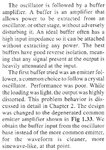
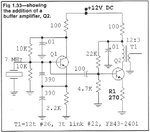
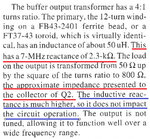
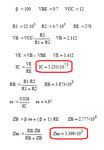
Q6: Now we have a 2.3KΩ at the collector of Q2, and the 50 Ω load is reflected to be 50*16 =800 ohm, My question is why the designer did not make the ratio 12:2, so we have 50*36 = 1800 ohm? I think it's the best and we can transfer greater power?
Q7: To calculate the input impedance (Zin) of the buffer (Q2 stage)
Is Zin (=3.4K) big enough to not load the oscillator?